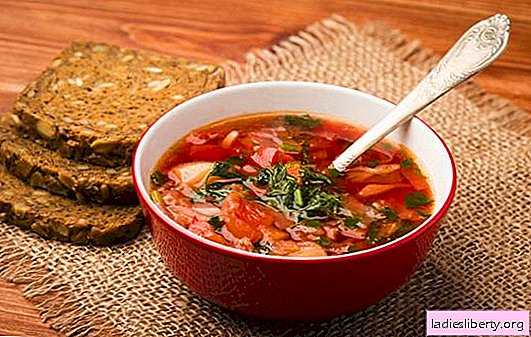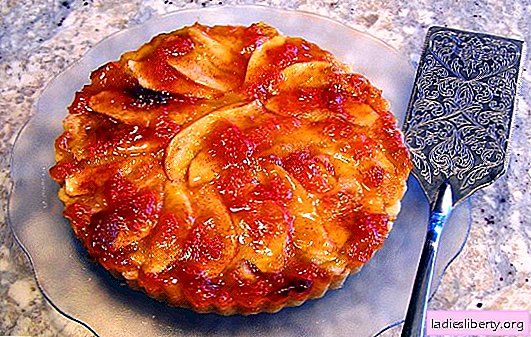
Foreign tourists unanimously declare that Russian cabbage soup is the first dish that you need to try while traveling in Russia. Like this!
Most likely, the secret of Russian cabbage soup is in special technology. After all, the first dishes with cabbage are available in almost every kitchen in the world, and they knew how to make sauerkraut in Ancient China, during the construction of the Great Wall of China.
Let’s try to understand what we know about Russian cabbage soup such that for the second millennium they remain the main dish on the Russian table, without submitting to the influence of our neighbors, but conquering Europe, Asia and even the New World.
Russian cabbage soup - basic technological principles
It is enough to read fluently several cookbooks written in Russia from the seventeenth to the beginning of the twentieth century to independently determine the characteristic features of Russian cuisine. The ancient recipes of Russian cabbage soup are based precisely on these centuries-old principles of cooking in Old Russian cuisine, which, oddly enough, are still preserved. Four significant differences can be distinguished from them:
1. In the ancient recipes of ancient Russian cuisine there is no such thing as grinding ingredients at the preparatory stage. Meat and vegetables were laid in the pot as a whole or in large pieces.
Compare: the habit of cooking meat in a whole piece for soups, borscht, broths and cabbage soup remains in our days. In this form, meat is laid in cabbage soup, although more than three centuries have already passed, when Russian cuisine mastered the preparation of meat, fish and vegetable minced meat, cutting meat for hodgepodge, goulash, under the influence of French cuisine, constantly competing for the title of "trendsetter" in cooking . Also, the cooking of the southern and eastern neighbors, Turkic and Asian peoples had a significant influence on the methods of preliminary preparation of products.
2. Spicy roots and herbs have been used in ancient Russian cuisine since the ninth century, even in poor peasant families: horseradish, garlic, dill, onion, parsley, anise. Note that Russian cuisine until the beginning of the twentieth century had clear social boundaries, therefore, various overseas spices, gradually penetrating into it, were available only to the boyar and merchant nobility, and, of course, to the clergy. Middle-class dishes have long been distinguished by a minimum of aromatic additives, although bay leaves, cloves and black pepper were known in Russia in the tenth century.
Remember: as early as in the second half of the last century, our grandmothers and great-grandmothers prepared excellent first courses, while doing so with a minimum set of spices, consisting of bay leaves, black and Jamaican (allspice) peppers, and spicy herbs and roots used mainly parsley, celery, dill, onions and carrots.
3. From the very beginning of its formation, Russian cuisine was distinguished by the unicomponent nature of dishes, that is, cabbage soup was called cabbage soup, even when it consisted only of cabbage (base) and onion (spicy dressing). The same component minimalism was characteristic of Russian salads, which included only cucumbers , or just beets, with the addition of spicy dressing. According to this principle, meat, mushrooms, fish were prepared.
The fewer ingredients that make up a dish, the more difficult it is to cook. This is a pattern in cooking. Perhaps this feature brings closer to unraveling the unique taste of simple Russian cabbage soup, and the technology of a simple dish has acquired its uniqueness, thanks to thousands of years of experience.
4. Now, it is unlikely that one of the housewives who use the Internet and other benefits of modern civilization has a Russian stove in the house, or at least knows how to start a fire in it. But it was the Russian oven that played, hardly, a decisive role in the formation of Russian cuisine, in particular - the methods of heat treatment of dishes.
Cabbage soup, usually placed in the oven after baking bread, and languished at a falling temperature until cooked, insisted before dinner. It was the device of the Russian oven, which was different from European stoves, on the surface of which it was convenient to pre-fry or sauté the components of the dish, combining several methods of heat treatment, set a certain direction: in the Russian oven, any dish was either baked, stewed, or cooked at the lowest temperature.
Cabbage soup and porridge, meat and fish, pies and bread, vegetables, fruits and mushrooms, old Russian drinks - everything was prepared in the oven, the prototype of modern, gas and electric ovens, combi steamers, microwave ovens, and European-style plates appeared in Russia during the Petrine era. At the same time, complex heat treatment of cabbage soup appeared, including the passage of spicy and acidic dressings.
But, as before, the simmering regime is considered to be a classic for cooking cabbage soup, and there are hundreds of recipes for cooking cabbage soup in the oven or multicooker, in accordance with ancient traditions. This method of preparation fully preserves the taste and aroma of real Russian cabbage soup.
It remains to add that, in addition to the listed features, a variety of recipes for Russian cabbage soup replenish the notebooks of culinary experts, thanks to regional features. Russian cabbage soup differs in composition of ingredients, depending on local cuisine: Pomeranian cabbage soup from salted or smoked fish, cabbage soup Ural and Siberian, Don and so on. Cabbage soup can be peasant, boyar, monastery, Cossack. Considering that most of the calendar days of the year in the Orthodox calendar are lean, Russian cuisine throughout the history of Christianity in Russia has been enriched with recipes for soup without meat and dairy products, while lean soup from mushrooms, vegetables and fish in it is no less than meat, companions.
But the main ingredient is always cabbage, or something that can replace it: spinach and sorrel, nettle, and sour. Without the acidic component of cabbage soup - not cabbage soup. Sour and spicy dressing are also required for this dish. Until the middle of the seventeenth century, whitewash, of sour cream, cream or flour (for lean soup), was also an obligatory component, but with the introduction of transparent French broths, many recipes of transparent soup were appeared. In this case, even for the first dishes prepared on the basis of broths, it is customary to serve sour cream, sometimes mayonnaise, apple with horseradish or other sauces that serve as whitewash.
You can talk about Russian cabbage soup for an infinitely long time, but as they say, it’s better to see once ... or it is better to cook and try once - you won’t be full of conversations.
1. Russian cabbage soup green, with nettles
Ingredients:
Beef (brisket) 1.2 kg
Ham 400 g
Roots: carrots, parsley, celery - 1 pc.
Leek 1 pc.
Onion, 2 pcs.
Nettle (young shoots) 600 g
Butter 60 g
Flour 50 g
Spicy leafy greens
Sour cream, homemade 250 g
Boiled eggs 5 pcs.
Cooking:
Cook the broth with roots and strain. Sort nettle, wash and put in boiling water. Boil, fold through a sieve, then wipe or kill with a blender. Fry flour in a pan, add oil, mashed nettle and a little broth. Bring to a boil and pour into broth. Cut the meat into pieces, and also add to the broth, boil. Add sour cream to cabbage soup, add chopped greens. Serve by putting in a plate half of hard-boiled eggs.
* If desired, nettles can be replaced with sorrel or spinach.
2. Lazy Russian cabbage soup from fresh cabbage with apples
Ingredients:
Apples, sour (large) 5 pcs.
Set for broth (pork with bone, chicken) 2.1 kg
Spicy dressing: bay leaf, pepper, roots
Fresh white cabbage 1.2 kg
Flour 90 g
Butter, nut 120 g
Greenery
Sour cream 300 g
Spice
Cooking:
Cook the broth, as usual, and strain. Put chopped cabbage, peeled apple slices, pieces of meat separated from bones in a pan. Mix the butter with flour and sour cream, add the acidic dressing to the broth. Simmer in the oven until soft. Chop the greens and add it to the tureen before serving.
3. Russian cabbage soup - an unusual recipe
Try to use the ancient culinary secrets of Russian cuisine. This recipe is taken from the cookbook "A Guide for Young Housewives," 1870. It was compiled by Naydenov, who used earlier editions in his book dating back to 1760. In the recipe, the weight measures are recounted and adapted to the modern system.
Ingredients:
For red broth:
Beef (ribs with pulp) 1.6 kg
Beef Fat 300 g
Roots (in assortment) - to taste
Water 4.0 L
For cabbage soup:
Cabbage, fresh 1.5 kg
Holland cheese 250 g
Sausages (any) 4 pcs. (approximately 600 g)
Madera 300 ml
Salt
Ground Nutmeg
Red broth 2.5 l
Cooking Technology:
Red broth is not water tinted with beets or tomatoes, but a special technology for producing very saturated broth from baked meat and vegetables.
Preheat the oven to medium temperature. Lay out coarsely chopped roots on a baking sheet. It can be halves of large onions, carrots, celery, parsnips, parsley. Between them put pieces of soft internal fat and ribs, or any bones on which enough pulp should remain. Bake in the oven until caramelized.
It is not necessary to salt the meat during baking, but, here, add fragrant spices, grease with honey or some sweet and sour berry sauce, to speed up caramelization, but it is necessary to lubricate the meat in the semi-prepared stage so that it does not burn much.
Put the baked meat with vegetables in a pan, fill with water. Water will be needed as much as is necessary to cover the meat. Bring the broth to a temperature close to the boiling point over high heat, then switch to the simmer mode. Cooking time for red broth: in the oven - 1.5 hours, on the stove - about an hour. Then strain it.
Ready broth can be stored frozen and used as needed. Of course, for original, even very sophisticated Russian cabbage soup, such a broth is best prepared in advance.
Put shredded cabbage in the pan, along with grated Dutch cheese, beef pulp and chopped sausages. Pour all the ingredients in the broth and cook until the cabbage is soft. Remove the cabbage soup from the stove and pour the wine into the pan. When serving, put on the table appliances with salt and ground nutmeg, in Russian. You can decorate with spicy herbs and a slice of lemon.
4. Russian cabbage soup, lazy teams
You will need:
Ham 600 g
Chicken fillet 800 g
Beef and fatty pork (pulp) 1.2 kg
Sauerkraut 1.5 kg
Turnip and spicy roots in assortment - 150 g each
Parsley, green 100 g
Sour cream 200 g
Oil 90 g
Flour 100 g
Cooking:
Cut all the ingredients and immediately fold them into cast iron utensils, feed parsley and sour cream. Pound the butter with flour and add to the total mass. Fill with water and simmer in the oven until cooked. Add sour cream and chopped parsley to a plate before serving.
Note: turnips, of course, can be replaced with potatoes, but remember that a forgotten turnip perfectly stimulates the immune system, and potatoes contain starch, that is, carbohydrates, and stimulate a trip to the gym to fight excess weight. If there is no good and old Russian turnip, then in this recipe you can do without potatoes.
5. Russian cabbage soup from young veal with spinach and asparagus
Composition:
Pulp, beef 2.5 kg
Roots for broth 250 g
Spinach 900 g
Asparagus 400 g
Oil 120 g
White bread 600 g
Pepper
Boiled eggs 6 pcs.
Chopped greens
Salt
Cooking:
Cut the meat into portions, put with the roots in the pan. Stew in the oven until cooked. Strain the broth. Return the meat to it, boil, add the prepared green mass and cook until soft. In each serving, put chopped boiled eggs, parsley. Serve salt and pepper separately. Toast, prepare croutons. Cut white bread into thin slices, spread with butter and bake in the oven.
6. Russian beef cabbage with sour cabbage and grits
Ingredients:
Meat (fillet) 800 g
Bay leaf, spices
Oatmeal 100 g
Sour cabbage 1.0 kg (with brine)
Onions 200 -250 g
Order of preparation:
Cut the meat, put it in a pan, add 2.5 l of water and cook to a boil, then, after removing the foam, add the bay leaf and a mixture of peppers. Cook for ten minutes, then add the chopped onions, cereals and cabbage with brine. Cook the cabbage until soft over low heat. Salt to taste a few minutes before being cooked.
Oatmeal can be replaced with any other, to taste.
7. Russian cabbage cabbage with kvass
Ingredients:
Meat 1.2 kg (any)
Onions, parsley, celery - for broth
Kvass and water (1: 1) 2.5 l
Greenery
Sour cream
White cabbage 1.0 kg
Spice
Technology:
Pour the meat with kvass and water, cook until half-cooked, and then add the chopped roots of celery and parsley, onion. Stew until the meat is tender. Add chopped cabbage and chopped greens. Season with spices. Serve with sour cream.
Russian cabbage soup - useful tips
- Cabbage soup based on vegetable or mushroom broth should be salted at the very end of cooking.
- To introduce cream or milk into a boiling broth, and to avoid clotting, pour a part of the broth from the pan, cool it and mix with milk. Then heat the separately prepared mixture and pour into the broth.
- So that the cabbage soup on the fish broth does not have an unpleasant fishy smell, soak the cleaned and washed fish in vinegar, or prepare water with lemon juice and zest. Well eliminates the fishy smell of bay leaf, cardamom. In ancient Russian cuisine, fish shea was cooked on the basis of broth from an old rooster, black grouse, and quail.
- To make sauerkraut a really useful product, do not add sugar and vinegar when salting. This method of harvesting will take a little longer, but the content of probiotics will increase markedly.











